|
|
|
Sort Order |
|
|
|
Items / Page
|
|
|
|
|
|
|
| Srl | Item |
| 1 |
ID:
074802
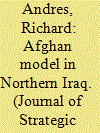

|
|
|
|
|
| Publication |
2006.
|
| Summary/Abstract |
In Operation 'Iraqi Freedom', as the Coalition's heavy forces fought in the South, in the North a handful of special operations forces, working with Kurdish rebels, clashed with the Iraqi army along the Green Line. In operations reminiscent of those used a year earlier to defeat the Taliban in Afghanistan, the lightly armed and heavily outnumbered Coalition forces called in air strikes to defeat Iraq's regular and Republican Guard army divisions. This article tells the story of these operations and discusses some of their implications for future US military policy. The success of the Afghan model in Iraq goes a long way toward demonstrating the efficacy of new air-heavy tactics and shows the strategic value of using light indigenous allies to replace heavy US land forces in both conventional combat and occupation operations.
|
|
|
|
|
|
|
|
|
|
|
|
|
|
|
|
| 2 |
ID:
080866
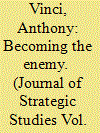

|
|
|
|
|
| Publication |
2008.
|
| Summary/Abstract |
The United States and Al Qaeda represent two fundamentally different forms of warfare. The US, with its basis in the Western way of warfare, relies on an almost totally instrumental form of warfare and Al Qaeda, with its basis in the Islamic way of warfare, fights an expressive, existential form of warfare. This paper illustrates how both sides' ways of warfare are converging toward each other. It also argues that this is in fact a good thing because it will allow the US to understand its enemy and thereby allow the US to defeat him in terms he can understand
|
|
|
|
|
|
|
|
|
|
|
|
|
|
|
|
| 3 |
ID:
065917
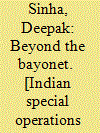

|
|
|
|
|
| Publication |
New Delhi, Gyan Publishing House, 2006.
|
| Description |
304p.
|
| Standard Number |
8121208610
|
|
|
|
|
|
|
|
|
|
|
|
Copies: C:1/I:0,R:0,Q:0
Circulation
| Accession# | Call# | Current Location | Status | Policy | Location |
| 050161 | 356.160905/SIN 050161 | Main | On Shelf | General | |
|
|
|
|
| 4 |
ID:
161001
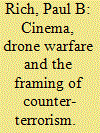

|
|
|
|
|
| Summary/Abstract |
The study of the cinematic representation is extremely useful in framing of counter-terrorism policies, whether in the US or elsewhere. This paper examines cinema’s interest in drone warfare as well as the lives and personalities of drone pilots. It argues that drone warfare suffers a considerable image problem that has been brought out in several recent features and it is unlikely that any major cinematic myth of drone warfare will easily develop, certainly in comparison to myths concerning special forces and special operations.
|
|
|
|
|
|
|
|
|
|
|
|
|
|
|
|
| 5 |
ID:
117559
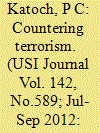

|
|
|
| 6 |
ID:
153644
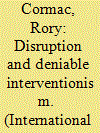

|
|
|
|
|
| Summary/Abstract |
The United Kingdom has long engaged in covert action. It continues to do so today. Owing to the secrecy involved, however, such activity has consistently been excluded from debates about Britain’s global role, foreign and security policy and military planning: an important lacuna given the controversy, risk, appeal and frequency of covert action. Examining when, how and why covert action is used, this article argues that contemporary covert action has emerged from, and is shaped by, a specific context. First, a gap exists between Britain’s perceived global responsibilities and its actual capabilities; policy elites see covert action as able to resolve, or at least conceal, this. Second, intelligence agencies can shape events proactively, especially at the tactical level, while flexible preventative operations are deemed well suited to the range of fluid threats currently faced. Third, existing Whitehall machinery makes covert action viable. However, current covert action is smaller scale and less provocative today than in the early Cold War; it revolves around ‘disruption’ operations. Despite being absent from the accompanying debates, this role was recognised in the 2015 Strategic Defence and Security Review, which placed intelligence actors at the heart of British thinking.
|
|
|
|
|
|
|
|
|
|
|
|
|
|
|
|
| 7 |
ID:
171609
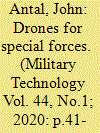

|
|
|
| 8 |
ID:
080439
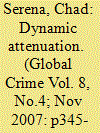

|
|
|
|
|
| Publication |
2007.
|
| Summary/Abstract |
This article analyses the ability of the US Army Special Forces to combat illicit networks (criminal and terrorist) through 'dynamic attenuation'. It is argued that a process of dynamic attenuation, where network ties and not the actors in the network are targeted, should replace the current US strategy of 'killing or capturing' criminal agents threatening US interests. By dynamically attenuating (not destroying) the ties between and among criminal actors and criminal organisations, the US can effectively reduce the capability of criminal organisations to operate and achieve their missions (profit and/or terror). This argument is substantiated by assessing the environments where criminal networks thrive, the characteristics of criminal networks, the utility of targeting networks instead of individual actors, and through a comparison of criminal organisations' and US Army Special Forces' strengths and weaknesses. This article concludes with implications and recommendations for US policy in the fight against criminal organisations
|
|
|
|
|
|
|
|
|
|
|
|
|
|
|
|
| 9 |
ID:
133051
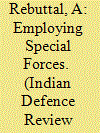

|
|
|
|
|
| Publication |
2014.
|
| Summary/Abstract |
In the Indian context, the Parachute Brigade, being the only formation of its kind available nationally, has performed the dual role of being a strategic reserve tasked for conventional operations, and also that of acting as a rapid reaction force capable of intervention/forced entry in OOAC as was carried out during Op Cactus in the Maldives in 1988. This latter role has subsequently gained in importance due to the nuclearisation of the subcontinent and the substantial reduction in operational battle space that resulted, and also because ot our increasing economic and geo-political clout in the region. Thus, we have created a unique beast, neither Ranger nor Airborne; a potent mix that fulfills both its roles in our area of influence and that has, over the years, met our requirements admirably.
|
|
|
|
|
|
|
|
|
|
|
|
|
|
|
|
| 10 |
ID:
117701
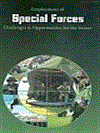

|
|
|
|
|
| Publication |
New Delhi, Vij Books India Pvt Ltd, 2012.
|
| Description |
vii,188phbk
|
| Standard Number |
9789381411285
|
|
|
|
|
|
|
|
|
|
|
|
Copies: C:1/I:0,R:0,Q:0
Circulation
| Accession# | Call# | Current Location | Status | Policy | Location |
| 057045 | 355.6/YAD 057045 | Main | On Shelf | General | |
|
|
|
|
| 11 |
ID:
093828
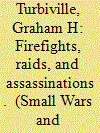

|
|
|
|
|
| Publication |
2010.
|
| Summary/Abstract |
This article examines some specific types of narco-generated combat, assault, and brutality that over the last decade have acquired an increasingly organized and paramilitary character. The planning; training; intelligence and counterintelligence preparation; mobility; communications; type of weaponry; levels of intensity; and sheer audacity substantially exceed the threats with which traditional law enforcement had been trained and equipped to deal. It matches the apt Drug Enforcement Administration description of a 'transition from the gangsterism of traditional narco hit men to paramilitary terrorism with guerrilla tactics'. These methods have become a mainstay in the struggle of narco-traffickers against law enforcement, the military, and to a major degree among the competing drug-trafficking organizations themselves. While the infrastructure and practice of paramilitary violence is established in Mexico in seemingly unprecedented ways, the concern north of the border is its potential transportability. Many law enforcement personnel have compared 1980s Miami - with its running drug firefights, revenge raids, and bloody assassinations by Colombian cocaine traffickers - to Mexican drug violence. There are enough precursors north of the Rio Grande now to make the potential for something analogous more than empty speculation.
|
|
|
|
|
|
|
|
|
|
|
|
|
|
|
|
| 12 |
ID:
070802
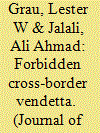

|
|
|
|
|
| Publication |
2005.
|
| Summary/Abstract |
In 1986, Soviet Special Forces conducted an unauthorized strike into Pakistan while attempting to wipe out a guerrilla base. The Special Forces were pinned down and had to call for Soviet air strikes to extricate themselves from an untenable position. This article discusses the planning, conduct and consequences of the mission.
|
|
|
|
|
|
|
|
|
|
|
|
|
|
|
|
| 13 |
ID:
156271
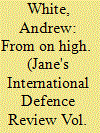

|
|
|
| 14 |
ID:
003503
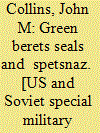

|
|
|
|
|
| Publication |
Washington, Pergamon Brassey's, 1987.
|
| Description |
xv,174p.
|
| Standard Number |
0080357466
|
|
|
|
|
|
|
|
|
|
|
|
Copies: C:1/I:0,R:0,Q:0
Circulation
| Accession# | Call# | Current Location | Status | Policy | Location |
| 028157 | 355.40973/COL 028157 | Main | On Shelf | General | |
|
|
|
|
| 15 |
ID:
089850
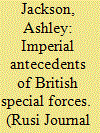

|
|
|
|
|
| Publication |
2009.
|
| Summary/Abstract |
Britain's special forces trace their lineage to the experience of empire: a long tradition of small units operating on the periphery of Britain's imperial possessions. The catastrophic defeats of the early part of the Second World War provided the impetus for special operations to carry on the fight while Britain prepared for the return to occupied territories.
|
|
|
|
|
|
|
|
|
|
|
|
|
|
|
|
| 16 |
ID:
137462
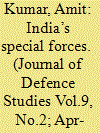

|
|
|
|
|
| Summary/Abstract |
At a time when the battlefield has been progressively transforming from the conventional to unconventional, the role of Special Forces will become critical in shaping its outcome. Conflicts in the past decade have established the primacy of such forces. Their role has evolved and today special operations are meant to be decisive and achieve strategic objectives. The Indian security establishment has also been taking notice of these changes and by and large making right moves. As India embarks on the path of high economic growth and becomes a power to reckon with, its troubled neighborhood poses the biggest challenge to it. The role of Special Forces will thus be critical in outwitting adversaries’ moves in the neighborhood and areas of India’s strategic interests, and in promoting India’s security.
|
|
|
|
|
|
|
|
|
|
|
|
|
|
|
|
| 17 |
ID:
091489
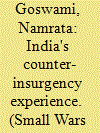

|
|
|
|
|
| Publication |
2009.
|
| Summary/Abstract |
The Indian Army, a force trained primarily for conventional warfare, has been engaged in internal counter-insurgency operations since the 1950s. Despite such a long innings on a counter-insurgency mode, little attention has been accorded within military circles to doctrinal innovation for waging sub-conventional warfare in India's democratic political context. At best, the Army continues to view counter-insurgency duty as secondary to its primary duty of defending India from external conventional threats. By conceptualizing a counter-insurgency strategy of 'trust and nurture', this article aims to fill this critical doctrinal gap in India's military policy. The author argues that a counter-insurgency strategy of 'trust and nurture' based on democratic political culture, measured military methods, special counter-insurgency forces, local social and cultural awareness and an integrative nation-building approach will result in positive handling of India's internal security problems. The author utilizes India's counter-insurgency experiences in Assam, Mizoram, Nagaland, Punjab, and Operation 'Sadhbhavana' in Jammu and Kashmir as illustrative empirical indicants in order to validate the 'trust and nurture' strategy.
|
|
|
|
|
|
|
|
|
|
|
|
|
|
|
|
| 18 |
ID:
133510
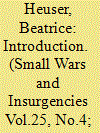

|
|
|
|
|
| Publication |
2014.
|
| Summary/Abstract |
When twentieth-century authors wrote about 'partisan warfare', they usually meant an insurgency or asymmetric military operations conducted against a superior force by small bands of ideologically driven irregular fighters. By contrast, originally (i.e. before the French Revolution) 'partisan' in French, English, and German referred only to the leader of a detachment of special forces (party, partie, Parthey, détachement) which the major European powers used to conduct special operations alongside their regular forces. Such special operations were the classic definition of 'small war' (petite guerre) in the late seventeenth and in the eighteenth centuries. The Spanish word 'la guerrilla', meaning nothing other than 'small war', only acquired an association with rebellion with the Spanish War of Independence against Napoleon. Even after this, however, armies throughout the world have continued to employ special forces. In the late nineteenth century, their operations have still been referred to as prosecuting 'la guerrilla' or 'small war', which existed side by side with, and was often mixed with, 'people's war' or popular uprisings against hated regimes.
|
|
|
|
|
|
|
|
|
|
|
|
|
|
|
|
| 19 |
ID:
133518
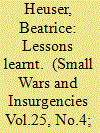

|
|
|
|
|
| Publication |
2014.
|
| Summary/Abstract |
Did participants in small wars in the period 1775-1831 learn from previous or contemporary examples? While this is difficult to prove for participants who left no written records, there is considerable evidence in existing publications by practitioners that they did indeed draw out lessons from recent insurgencies, either from their own experience or from events elsewhere which they studied from afar, especially the Spanish Guerrilla, which had already become legendary. Most authors showed an interest in how to stage insurgencies rather than in how to quell them. Even then, transfer did not come in a package of tactics-cum-values, but in each case in different configurations.
|
|
|
|
|
|
|
|
|
|
|
|
|
|
|
|
| 20 |
ID:
190721
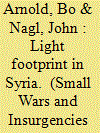

|
|
|
|
|
| Summary/Abstract |
Special Operations Forces (SOF) played an important role in defeating the Islamic State (ISIS) physical caliphate in Syria. Acting as a force multiplier, SOF successfully mobilized, armed, supplied, and directed an indigenous guerrilla force across northern Syria against a numerically superior entrenched enemy. This effort was underpinned by a flexible operational approach that adapted operational art to the unique characteristics of unconventional warfare. This paper provides a case study on the conflict with ISIS in Syria, focusing on the first phase of the campaign from 2014 until 2016, examining the elements of operational art which had the most significant impact on the outcome of the conflict. The application of operational art throughout the campaign sought to preserve and strengthen the friendly center of gravity – the Syrian Defense Forces, or SDF – by improving access to critical capabilities, controlling tempo, recognizing culmination criteria, and properly phasing operations and resources. SOF’s practice of sustained engagement garnered influence with the SDF and provided situational awareness to key decision makers, connecting tactics to strategy, engendering mutual trust, and allowing the agility that led to battlefield success.
|
|
|
|
|
|
|
|
|
|
|
|
|
|
|
|
|
|
|
|
|